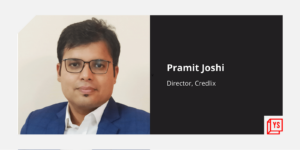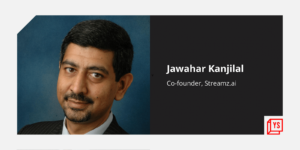At YourStory’s flagship event TechSparks’ maiden Mumbai edition Dhruvil Sanghvi, Founder and CEO, LogiNext Solutions; Bhavik Koladiya, CEO and Board Member, OTPless; Ninad Karpe, Founder and Partner at 100X.VC, and Mayank Kumar, Co-founder and MD, upGrad; came together for a panel discussion to debate whether to move fast and break things or go for sustainable growth.
The discussion began from a venture capitalist perspective.
On being asked about his preferred working style, despite there not being a one-size-fits all approach, Karpe said the firm had a ‘move fast’ philosophy. “We are going to invest in 100 startups this calendar year. We have already done 25 in the first three months. The good old days of hare and tortoise fables are over,” he said.
Karpe stated that the first approach (move fast) is the right one and that it “can be a little variation of both” because of a couple of reasons. Startups are meant to solve problems of tomorrow, they connect the dots and create the larger picture which others only see as dots – that can happen only if you are fast and furious. “It can’t be a month-on-month kind of a slow growth rate; it has to be a geometrical growth rate. All that can happen only with a fast and furious approach. Our mantra is scale or fail,” he explained.
Before 100X.VC, Karpe was the Managing Director at CA Technologies post which he went to work with IDBI Bank as a Director. Over 25 years, he served at multiple companies as Director including EDC, Slonkit, and Aptech. Since 2019, he is helping build and grow 100X.VC, which invests in early-stage startups and believes in the mantra of ‘moving fast and valuing time’.
Koladiya’s OTPless is a couple of years old, but he is a seasoned campaigner with ‘some hits, many misses (in his own words)’. We asked him what were the biggest learnings from failures that he could share with entrepreneurs to help them build better, quicker and hopefully see success?
“Every startup before BharatPe that I started up, I was always kind of scared to move fast because nobody will give the money. So it’s always been get the cash flow, reinvest in the business, and keep growing,” he said.
In the past five years he said he had learnt that if you really want to go and capture a large market share and build a meaningful business you’ll have to raise capital. “Because if you don’t scale, you fail; you are racing against time,” he said, adding that there needed to be disciple and clarity. “You need clear visibility that you will be able to recoup the value of whatever you invest, otherwise anyway you are going to fail, right?”
In 2017, Koladiya co-founded fintech platform BharatPe with Shashvat Nakrani and Ashneer Grover. In 2022, he became a managing partner at Finix Partners, through which he invests in ‘unconventional startups’. Now, through OTPless, he is working towards a mission where ‘any business can leverage the global power of WhatsApp to verify the mobile number of their users’.
Koladiya also stressed on the importance of managing cash flows optimally. “It’s your cash flow. The customer is paying money, you should preserve it and reinvest it, but if you have raised money from somewhere the hook is on you – if you don’t raise, you will fail.”
He advised that this is the best time to build a startup, adding that if you want to build a unicorn “you have one year to deliver, if you grow 5x in one year you still have a shot so don’t be afraid to move fast”.
Sanghvi, who has built a successful, global, multimillion SaaS business with LogiNext Solutions, a bird’s eye view of both, the Indian and the US startup ecosystems. So, we asked him about the US ecosystem versus the Indian one. How do the approaches for a startup typically differ when it comes to the ‘move fast and break things versus slow, patient, sustainable growth’?
“What I have seen in the US surprisingly and interestingly is that the cost of capital is not as cheap as it has become in India. That basically means that India has way more capital available for a few select strong founders,” he said. That leads to cultivating habits in an organisation where “you end up thinking this growth versus profitability or move fast and fail fast versus build a sustainable business kind of logic”.
He believes that there will eventually be a point where a founder won’t have to choose one over the other.
“In the US, they have kind of crossed that chasm as an ecosystem and there is enough knowledge, awareness, and founder quality available so people are not choosing one over the other. People are building agile organisations that can change with time because there is no one answer. You can neither say that I have started a company and I am always going to be in hyperscale mode at any cost, you can neither be very conservative when it comes to growth,” he said.
Sanghvi added that a significant number of companies have gone public in the US and there is enough information available in terms of business models during that time.
“A lot of data sets are available even for private investors to extrapolate from companies’ long journeys of 15-20 years…how those companies performed in public markets, how the way the waves happened, what public markets truly value – growth or profitability for a particular kind of business model. The US ecosystem has that edge. India will get there over the next five to seven years as more companies go public,” he said.
Lastly, we asked upGrad’s Kumar if he believed that the edtech industry in general grew too fast too early and is now having to rationalise with the unfortunate job cuts?
Kumar set the context by stating that edtech is a very broad word, with two different segments and that the impact has been greater in the K-12 segment than in the higher education/professional one.
“When COVID hit, a lot of offline shut down and demand was created for online. Schools, tuition centres, and coaching classes shut down and a lot of K-12 demand went to online, which grew very rapidly. Capital became very cheap,” he said.
He said money was ample and founders went ahead to capture as much market share they could due to the macro shift. In the process, they hired a lot of sales and marketing teams, with a focus on acquiring customers as education is not a ‘pull product’.
On the issue of ‘slow and steady versus move fast’, Kumar stressed that education is a ‘slow and steady’ product. However, people went for the kill very aggressively given the market opportunity.
“The moment offline started, demand [dwindled] but people had been hired. What you are seeing is an impact of that,” he said.
In hindsight, what could have been done differently?
“If capital was used for outcomes, to provide the right learning results, we would have been in a very different ecosystem. We had the environment to demonstrate outcomes but most people demonstrated sales and marketing prowess. That’s where the fundamentals sort of shifted, but people now get the point,”
Kumar now expects conversations to revolve around outcomes, which will set the course for the edtech industry in the days to come.











